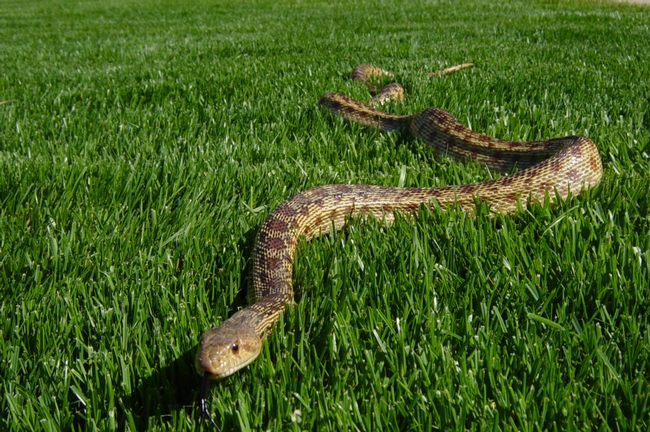
Of course, we were wowed by all the incredible plants from around the world that we got to see, but we were especially excited about the snakes!
I know you may not want to adopt a pet snake — although many people do — but they are extremely beneficial to have slithering around your garden and landscape. Snakes prey on mice, rats, moles, voles, lizards, frogs, slugs, and even other snakes.
More than 30 species of snakes make the Bay Area home. Of those, only rattlesnakes are venomous to humans.
The Pacific gopher snake is the most common snake in Northern California and is often mistaken for a rattler. It is generally brown or tan with dark gray, black or brown spots along the length of its body. Adults are 4 to 5 feet long.
This snake is diurnal, meaning it hunts during the day and sleeps at night. It is found in woodlands, grasslands, chaparral, agricultural and riparian areas from sea level to the mountain ranges. If threatened it will flatten out its body and shake its tail. Although it has no rattle, the movement against dry grass can mimic the sound of a rattlesnake.
The Northern Pacific rattlesnake can range in color from olive to brown to black. It has dark brown and tan blotches along its body and medium to dark bars at the tail. Adults are typically 3 to 4 feet long.
Usual habitats include seaside dunes, rocky hillsides, woodlands, grasslands, and sometimes residential landscapes. You will often find them on hiking trails or bike paths, soaking up the sun.
A rattlesnake has a triangular head and a relatively thin neck. The body is thick, dull and non-glossy. A gopher snake's head is more pointy and just a bit bigger than its neck. It has a slender, glossy body and a pointed tail.
King snakes are extremely common throughout California. They are either black or dark brown with light striped bands circling their bodies. Adults are generally 3 to 4 feet long.
They can be found in nearly all habitats — forests, woodlands, grasslands, wetlands, and even the desert. They have been known to eat rattlesnakes as they are immune to the venom.
The Northern Rubber Boa is usually a fairly solid shade of brown, tan, pink or olive green. It has small, smooth scales and looks, well, very much like rubber. It only grows to about 2 feet in length.
Although Boas are very common, they are generally nocturnal so you may not see them. They are often found in meadows, grasslands, chaparral, and deciduous and coniferous forests.
Pacific Ring-necked snakes are beautiful small, thin, smooth-scaled snakes. They are black, gray or dark olive green with vivid orange rings around their necks. The underside is bright yellow or orange with black specks. They only grow to about 3 feet long and will coil their tails (showing off their bright colors) when threatened.
They like moist habitats such as wet meadows, gardens, farmland or forests. They eat insects, worms, lizards, salamanders, and tadpoles.
Other common snakes you may find while out hiking, biking or even hanging out in your backyard are Night snakes, Striped Racers, Sharp-tailed snakes, and many others.
You may not learn to love your snakes, but please learn to appreciate and respect them. They really are quite good at taking care of the rodents that are wrecking your lawn and eating your tomatoes!
By UC Master Gardener Rebecca Jepsen
This article first appeared in the June 16, 2019 issue of the San Jose Mercury News.
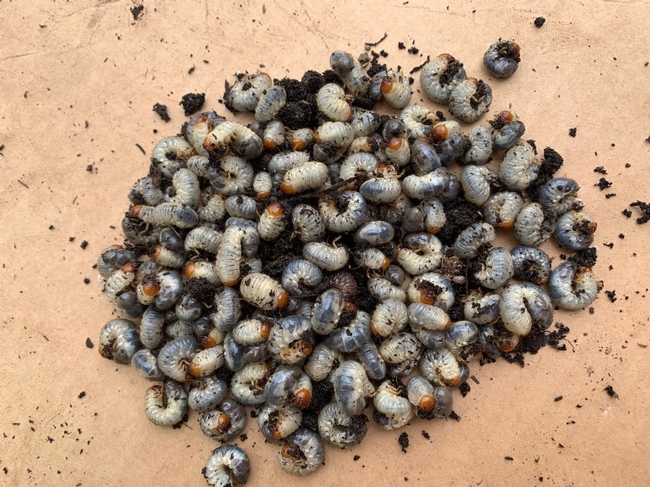
White grubs are the larvae of several species of scarab beetles. They are weird, kind of alien-looking little creatures that curl up into a C-shape when disturbed. They tend to grow to around 1-inch long, but some species can get much larger.
I have three raised beds in my garden area and replant them every spring and fall.
For the last couple of years, I have found an unusually large population of what I believe is a kind of grub called Cyclocphala, or masked chafers. The larvae have brown heads and legs and have dark stripes across their backs. The adults (beetles) are golden-brown and have an almost armor-like, shiny coating on them.
“It is not possible to identify these grubs without looking closely at features such as mouthparts and small hairs (called setae) located on their bodies,” said Karey Windbiel-Rojas, with the University of California Statewide Integrated Pest Management Program.
“However, they are the larvae of scarab beetles, and based on where you found them, they could be masked chafers, green fruit beetles, or something similar. What they are very likely NOT are Japanese beetle larvae, since those are more or less non-existent in California.”
Handpicking grubs from raised beds (as I do) and containers can be all the control needed. I have had no noticeable plant damage in my beds.
If you or a neighbor have chickens, they absolutely love grubs and will be overjoyed to help you cut down the population.
Grubs can, however, do major damage to turfgrass. Most damage occurs during late summer or early fall. You will see patches of brown, drying lawn in the infested areas.
Additional damage is often done by moles, voles, birds or skunks that are digging in the grass to feed on the grubs.
Before taking any control measures, dig around the root level of the grass to confirm that in fact the damage is caused by grubs. If you find more than six grubs per square foot, you may want to take action.
Since grubs feed close to the surface, aerating the soil can kill significant numbers of them.
Nematodes (tiny, microscopic roundworms) can also be applied to control grubs. They should be applied when the grubs are young and not overpopulated.
It is best to do so in late summer or early fall. A second application is highly recommended. Be sure to do your research about the proper way to prepare and apply nematodes for grub control.
If these natural measures don't work, it is important to know what kind of grub (or any other kind of pest) you have before deciding to use chemical control.
Get advice about the right chemical to use and the right amount necessary to get the job done. A wrong decision can mean wiping out other species.
You can take a grub (or another pest) specimen into your local Master Gardener office to get information about what to do.
by UC Master Gardener Rebecca Jepsen
This article first appeared in the May 19, 2019 issue of the San Jose Mercury News.
All that rain was a little too much for some plants
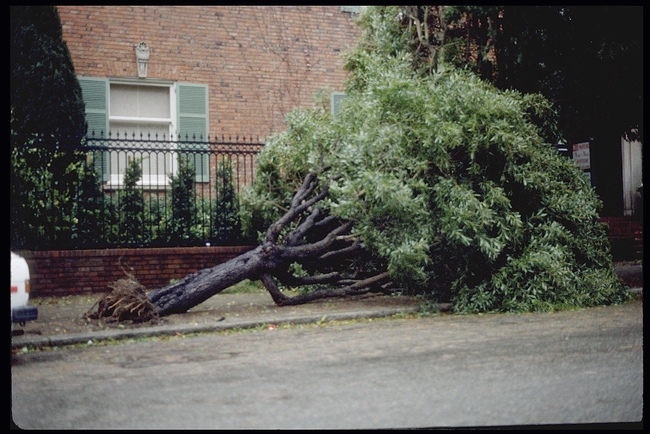
Many plants have become waterlogged, showing signs of stress through their leaves, which might have twisted and turned yellow or brown. Water stressed plants also might have darkened veins and midribs. The plant often will lose its leaves and new shoots might wither and die.
The symptoms of too much water mirror those of too little water, and there's a reason for that. In both conditions, the plants are robbed of oxygen and nutrients.
Fortunately, the time of year might save many plants. During the winter months most plants are in a dormant or slower state of growth so less damage occurs versus summer floods or monsoons when the plants are actively growing and taking in oxygen and nutrients from the soil.
If you have water-damaged plants, here are some things to do, and not do:
• Stay off wet soil as much as possible. Compaction will only increase the risk of damage.
• Wait until all chance of frost has passed, then trim off damaged branches, shoots and leaves.
• If you are growing in containers, make sure to elevate the pot a few inches off the ground so that water can drain through and away from the roots. If possible, remove the plant from the container and place it on cardboard or newspaper overnight to let it drain. Clean the pot and replant with fresh potting soil and slow-release fertilizer.
• If you are in an area that has flooded, it may be best to discard edible plants that have been submerged in water. According to research from North Carolina State University, flood water may carry pathogens such as E. coli, Salmonella, Hepatitis A and norovirus. The water can spread contaminants throughout the entire garden especially if there is livestock, a pet area or compost pile nearby.
• Produce that is consumed raw, including soft fruit like berries, should definitely be discarded. Plants that were in flower during the flood might be safe, but it's probably best to throw them away as well.
• Root crops that have four or more weeks left before harvest should be OK, but they need to be washed and rinsed thoroughly before eating. Canning produce is not advised.
• Add compost and mulch in late spring or early summer to help reestablish nutrients in the soil.
• If you lose some plants or trees, plant new ones on mounded soil that has been well amended to improved drainage.
• If you are concerned about a tree coming down, consult with a licensed arborist.
• Don't be too quick on the draw with those pruning shears and shovels. Plants are amazingly resilient and may make a full recovery once the rain stops and we get more sunny days.
by UC Master Gardener Rebecca Jepsen
This article first appeared in the March 5 issue of the San Jose Mercury News.
Sheltering fragile plants this winter
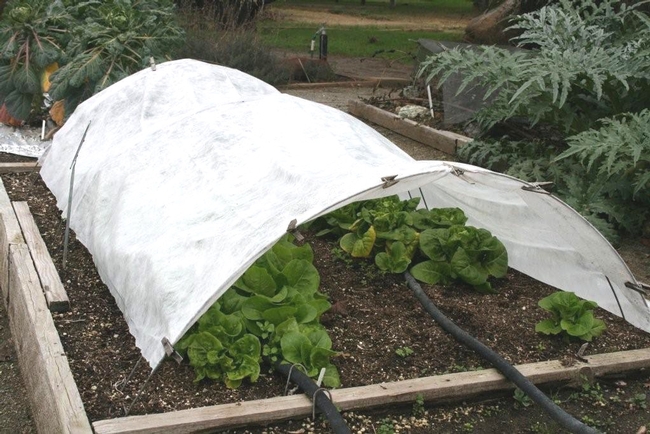
In the Bay Area we are also fond of some non-native but wonderful plants. Some are particularly susceptible to frost injuries. So this winter, as you reach for that big soft blanket folded up at the end of our couch, don't forget those beauties in your garden that need a little warming up as well. If you have citrus, bougainvillea, succulents, avocados, or fuchsias in your garden then I'm talking to you. And, unless you're willing to share your blanket (answer: no) then you should have a frost plan. An ounce of prevention for your plants will keep you warm and cozy on the couch. So, take a few minutes to prepare for the next time you find Jack Frost nipping at your rose (couldn't help it…and, side note, roses are very hardy and do not need protection):
- Water the ground around your plants thoroughly to moderate the soil temperature and protect the root zone.
- Wrap (non-LED) holiday lights around the branches of your shrubs and small trees. The small amount of heat they give off is often just enough to ward off the cold. And they're just so darn festive!
- If you haven't yet thrown out your Christmas tree, cut off the branches and pile them up at the base of your plants to keep them cozy. Any other spruce/pine boughs will do.
- Purchase floating row cover from a garden supply store or forage burlap sacks from your local coffee roaster. Wrap and/or drape either of them lightly over your plants. Then enjoy a cup of coffee.
- Bring potted succulents or other tender plants up on the porch where they can bask in the radiant heat of your house.
- Build an elaborate PVC or wood frame around your plants and drape plastic over them. No, on second thought, don't do this. Choose plants that are more suited for your area and you can avoid this all together!
And now, grab that blanket on the couch and sing with me…baby (kale) it's cold outside…
by UC Master Gardener Cayce Hill
This article first appeared in the January 20 issue of the Morgan Hill Times.
By growing different varieties in your garden, you can pick berries year round!
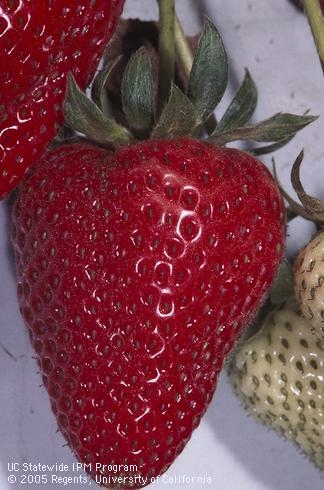
The home gardener loves them, too, and because of our climate and the variety of berries available, we can enjoy pretty much a year-round harvest.
Here are some tips on fulfilling your strawberry dreams:
Berries like full sun and soil that drains well. They also need potassium, so add pot ash when planting in clay soil.
Don't plant where you have grown tomatoes, eggplants or peppers as strawberries are susceptible to verticillium wilt, a fungus that can infect the soil and damage or kill the plant.
Strawberries have shallow roots and need to be watered frequently. Keep plants moist but not soggy.
Strawberries do best when refreshed every year. Dig up and discard of the mother plant. Snip off and replant the healthiest runners that are putting out strong roots and, to ensure large harvests and superior taste, plant new plants every 3 to 4 years.
Varieties
Strawberries fall into three primary categories: Everbearing, day neutral and June bearing.
Everbearing requires long days of sunlight to set fruit and, although they don't bear all year-round, they produce multiple crops in spring, summer and fall.
• Mara Des Bois, developed by a French breeding program, produces small, extremely fragrant, very flavorful fruit.
• Quinault produces up to 2 inch berries that are exceptionally sweet, great fresh or in preserves. It grows well in containers.
• White Carolina, or pineberry, is a unique white to pale pink berry that tastes like a cross between a strawberry and a pineapple. It produces medium size fruit from spring through fall and is heat tolerant and disease resistant.
Day Neutral berries do not depend on a set number of daylight hours in order to flower. They are a great choice if you want a small amount of fruit throughout the year.
• Alpine, sometimes thought of as wild strawberry, is a compact, clumping variety that can be grown in part sun. It has small, aromatic, rich tasting berries. Plants do not sent out runners so it makes a great edging option.
• Albion produces large, firm very sweet berries. It is disease resistant but needs more water and nutrients than other varieties. It spreads out rapidly, so space accordingly.
• Seascape, produced by the University of California in 1992, is productive. Many think it has the best flavor that any of the day neutral varieties.
June bearing strawberries require short day lengths, as in the fall, in order to flower. They are the most widely grown berry and make up the bulk of what you find at the supermarket. They tend to be vigorous plants, putting out lots of long runners, so require room to grow.
They are prolific producers of large fruit, but since the fruit comes on all at once you have to use it all pretty quickly. They are great for jams, jellies and pies.
Unlike the name implies, they don't all produce in June.
• Chandler offers good color and flavor, and the fruit holds well on the vine. It is susceptible to anthracnose disease.
• Earliglow is known for its wonderful strawberry flavor. The fruit is sweet, firm and medium sized. It produces vigorous runners, so give it plenty of space.
by UC Master Gardener Rebecca Jepsen
This article first appeared in the February 1 issue of the San Jose Mercury News.

